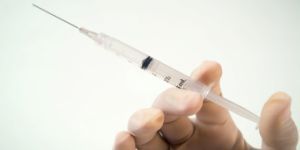Article
5-Year Efficacy Data Shows Golimumab Yields Long-Term RA Improvements
Author(s):
As a follow-up to the initial establishment of Simponi (golimumab)'s safety and efficacy in rheumatoid arthritis (RA), researchers presented final 5-year data evaluating the tumor necrosis factor (TNF) blocker's effects in RA patients taking methotrexate and those naïve to the biologic agent.

As a follow-up to the initial establishment of Simponi (golimumab)’s safety and efficacy in rheumatoid arthritis (RA) from the 2-year Phase 3 Golimumab for Subjects With Active RA Despite Methotrexate (GO-FORWARD) clinical trial, researchers presented final 5-year data evaluating the tumor necrosis factor (TNF) blocker’s effects in RA patients taking methotrexate and those naïve to the biologic agent during two separate poster sessions held at the American College of Rheumatology 2013 Annual Meeting in San Diego, CA.
In the first poster funded by Simponi manufacturer Janssen, Paul Emery, MD, MA, FRCP, of the Leeds Institute of Molecular Medicine, and investigators from research units in Pennsylvania, Texas, Nebraska, Argentina, Belgium, Australia, South Korea, and the Philippines reported the safety and efficacy results of 252-week subcutaneous golimumab treatment in 419 methotrexate-naïve RA patients.
Prior to the start of the long-term extension trial at week 52, patients were randomized to placebo plus methotrexate, 100 mg golimumab plus placebo, 50 mg golimumab plus methotrexate, or 100 mg golimumab plus one dose of methotrexate every 4 weeks, according to the poster authors. After the last patient completed 52-week treatment, “unblinding occurred and placebo plus methotrexate patients could switch to 50 mg golimumab plus methotrexate, methotrexate and corticosteroid use could be adjusted, and a one-time golimumab dose increase from 50 to 100 mg or decrease from 100 to 50 mg was permitted at the investigator’s discretion,” the authors wrote.
Observing the 5-year efficacy results among all participant groups, the researchers found that 20% improvement in RA (ACR20) at week 256 was attained by 88.8% of the 100 mg golimumab plus methotrexate group, 85.2% of the 50 mg golimumab plus methotrexate group, and 84.8% of the 100 mg golimumab plus placebo group, compared to 79.1% of the placebo plus methotrexate group.
Additionally, disease activity score (DAS28) and European League Against Rheumatism (EULAR) response based on C-reactive protein (CRP) at 5 years was achieved by 96.9% of the 100 mg golimumab plus methotrexate group, 93.4% of the 50 mg golimumab plus methotrexate group, and 95.1% of the 100 mg golimumab plus placebo group, compared to 90.6% of the placebo plus methotrexate group. The researchers also found that “64% of patients randomized to golimumab plus methotrexate had no radiographic (RA) progression."
Thus, the poster authors concluded that “golimumab plus methotrexate therapy resulted in maintained improvements in signs/symptoms of RA and in physical function, and inhibited structural damage progression long-term.”
In the second poster, which was also supported by Janssen, Edward C. Keystone, MD, FRCP(C), of the University of Toronto, and researchers across Pennsylvania, California, Chile, Australia, and Korea reported similar safety and efficacy results of 252-week subcutaneous golimumab treatment, but this time in 313 patients whose RA remained active despite prior methotrexate treatment.
For that long-term extension trial, patients were randomized to the same treatment groups and underwent the same unblinding and dose adjustment at week 52 as the first poster.
Although ACR20 and DAS28-CRP EULAR response rates among those patient groups were similar, the researchers did discover that 37.8% of the 50 mg golimumab plus methotrexate group achieved a 70% improvement in RA (ACR70) at week 256, compared to 23.1% of the placebo plus methotrexate group. In addition, DAS28-CRP remission criteria was fulfilled at the 5-year mark by 47.9% of the 100 mg golimumab plus methotrexate group, compared to 42.2% of the placebo plus methotrexate group
Though a higher percentage of patients randomized to golimumab plus methotrexate had radiographic RA progression compared to the first study, the authors of the second poster determined that “radiographic progression appeared controlled with small changes in mean van der Heijde-Sharp (vdH-S) scores.” Therefore, they arrived at the same conclusion as the authors of the first poster and wrote that “improvements in signs/symptoms of RA and in physical function were maintained long-term in patients continuing golimumab plus methotrexate therapy.”
In terms of cumulative safety data, the most common adverse events seen in golimumab patients between the 2 studies were upper respiratory tract infection and bronchitis. Additionally, nausea was reported by 19.6% of the 402 patients who completed the safety follow-up period in the first study, while nasopharyngitis was reported by 17.1% of the 301 patients who completed that phase in the second study. Roughly 12% of patients in the first study experienced an injection-site reaction, though fewer patients had the same reaction in the second study.
However, Emery and his co-authors ultimately concluded that “no new golimumab safety signals were detected through 5 years in methotrexate-naïve RA patients,” and Keystone and his co-authors noted that “the long-term safety data of golimumab is consistent with other anti-TNF agents.”
Both studies had high 5-year retention rates, as the first study retained 66.1% of patients, and the second study retained 70.5% of participants.





